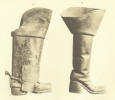
PLATE no. XI
Collection of Messrs. Tryrrell and Bennett.
No. 51. Military Jack boot worn at siege of Winchester in Cromwell’s time. It has a remarkably high heel, and shows a great want of technical education. The toe is square and blocked; the tongue is put in with a flat seam; the top is made very full.
No.52. Military Jack boot, with spur and rest; 1690. Similar to No. 49. Plate X.
A few notes collected by the author on spurs may not be uninteresting. They were worn as early as the Saxon period, when they consisted of a single goad. An early form of spur appears on an effigy in the Temple Church, London. About the Norman period, to suit the ankle, the shanks were bent. In the fourteenth century rowelled spurs first appeared; they were sometimes decorated with jewels and richly chased. They were always used at the tournaments. During the reigns of Henry V. and Henry VI. spurs with very long spiked rowels were worn, some measuring as long as six inches. In the reign of Henry VIII. these long-necked spurs went out of fashion, giving place to the close ones shaped like a star. At the battle of Cressy the Earls of Northampton and Arundel sent a messenger to the king, who was surveying the battle from an eminence, asking him for immediate aid for his son the Black Prince. When he had delivered his message, the king inquired, “Does my son live, or so wounded that he cannot help himself ?” “ God forbid, Sir,” the messenger replied; “he is closely beset, and your aid would be right welcome.” The king replied, firmly, “Return to those who sent you, and tell them from me, they must not send for me to-day as long as my son is alive. Let the boy earn his spurs.” The spurs were the distinguishing characteristic of knighthood, and the young knight sought to show himself worthy of them, or, in other words, to earn them by some gallant deed of chivalry. During the fifteenth and sixteenth centuries the custom of spur-money prevailed, jingling spurs being then worn, the noise of which disturbed the worshippers at divine service in the cathedrals. A penalty was claimed by the beadle and choristers from those who wore them. It was ordered that “if any knight or other person entitled to wear spurs enter the chapel in that guise, he shall pay to the choristers the accustomed fine.” There was one way of escaping the tax, the spur-wearer being held exempt if the youngest chorister present failed to repeat his gamut correctly upon being challenged to do so. This curious saving clause is set forth officially in a notice issued by the Dean of Chapel Royal in 1622. At this period Ripon in Yorkshire was famous for its manufacture of spurs. James I., when he passed through the town in i 617, was presented with a pair, and on that account they were sometimes called Rippons. On the belfry walls of All Saints’ Church, Hastings, hangs the following rhymed notice, declaring the belfry free “to all those that civil be,” with a proviso,
“If you ring in spur or hat,
Sixpence you pay, be sure of that.”
The knights of old were proud of their spurs. Lady equestrians adopted spurs at a very early period. The fops of Shakespeare’s day delighted to hear their spurs jingle as they strutted through the streets.